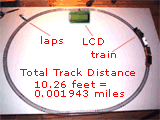ClipIt!
Share your clipboard with the
world.
Download:
Mac
Version (OS9)
1.8 MB (.sit)
Mac Version (OSX)
1.8 MB (.sit)
PC
Version
(Win 98/2k/Me/XP)
1.6 MB (.zip) |
MouseMiles
Screen miles to real miles.
Link: mousemiles
(Shockwave
Plug-In Needed)
|
MouseTraces
Share your mouse
across distance.
Download:
Mac
Version (OS9)
1.8 MB (.sit)
Mac Version (OSX)
1.8 MB (.sit)
PC
Version
(Win 98/2k/Me/XP)
1.6 MB (.zip)
|
Clicks &
Clicks_LiveMixer
Connecting clicks across the globe.
Download Clicks:
Mac
Version 1.2 (OS9)
1.8 MB (.sit)
Mac Version 1.2 (OSX)
1.8 MB (.sit)
PC
Version 1.2
(Win 98/2k/Me/XP)
1.6 MB (.zip)
Download Clicks_LiveMixer:
NEW! PC
Version 1.5
(Win 98/2k/Me/XP) - 2 MB (.zip)
PC
Version 1.0
(Win 98/2k/Me/XP) - 2 MB (.zip)
|
ClipIt! is a networked application that provides an
ambient connection to other people's desktops by distributing the
contents of each users clipboard. The project works as an automatic
Post-It or sticky note that is meant to allow people to catch a
glimpse of the cut and paste activity on other people's machines.
Copy and paste are ubiquitous elements of the modern computer GUI
interface. They are both infinitely useful for working with computers
and are integral elements to all computers across all platforms. Our
use of these functions is so natural that we even forget we use them
and without them our methods of computer interaction would change
dramatically.
More Info on ClipIt!. . . |
MouseMiles is a networked mileage indicator for your
mouse. Over time it calculates the mileage traveled by every
connected mouse and relays that information to a central server. The
server collects all of the incoming mileage and outputs the distance
in real-time to move a physical object - currently a model train
around a track.
The idea behind MouseMiles centers around our connection to familiar
objects (in this case a mouse) and how we share this connection and
use with others across distance. The mouse is a fundamental input
device to the modern computer. Despite our miniscule movements while
using it, over time these movements measure up to long distances
without us even noticing.
A picture of the physical installation:

More pics at mousemiles.
|
MouseTraces is an application that focuses on
background connectedness and awareness between two people across
distance. Looking at the specific relationship of networked computer
usage, the project captures mouse movements on the desktop and
transmits a graphical
Current connections between people separated by distance take place
during time specific intervals - i.e. when you have time to write
that email, call the other person, send them a letter in the mail, or
send them an Instant Message. Instant Messengers (ICQ, AIM, MSN
Messenger) are perhaps the closest thing we have to a constant
connection since when both people are logged in each is instantly
aware of the other person's presence, activity (away, busy,
available), and personal information. Still, the method of
communication between people connected to IMs requires foreground
activity such as opening a window, typing a message, and clicking the
send or return buttons. Instead of relying on this type of foreground
connection, MouseTraces keeps track of each person's desktop activity
in an ambient, non-intrusive way.
More Info on MouseTraces. . .
|
Clicks is a networked application that collects mouse
clicks made by each person connected. Once collected, clicks are sent
to a central server and each connected client is assigned a unique
tone which is played in a physical location (currently installed at
MLE), creating an ambient sound installation as an indicator of
computer activity and use on a global scale.
Clicks_LiveMixer allows people to "hear" the incoming clicks and mix
the sounds by changing pitch, tone, and duration of each note
associated with the incoming clicks. Version 1.5 allows for drag and
drop of users into specific pitch and tone coordinates that assigns
unique notes for each person connected.
Mouse clicks are ubiquitous elements of the modern computer GUI
interface. A mouse still exists as the key device we communicate and
interact with elements on screen. Our use of the mouse is so natural
that we even forget we use it and without it our methods of computer
interaction would change dramatically.
Clicks centers on this background activity of clicking.
Specifically, it looks at everyday computer activities and how when
shared, these actions take on new meaning. From providing a window
into computer usage in local communities (such as offices, homes,
schools, or events) to global use as distributed over the Internet,
Clicks allows an ambient link between computer users within the
desktop sphere. When multiple users are connected, their click total
is added to the collected total and distributed to everyone
connected.
Screenshot of Clicks_LiveMixer_v.1.5:

More Info on Clicks. . . |